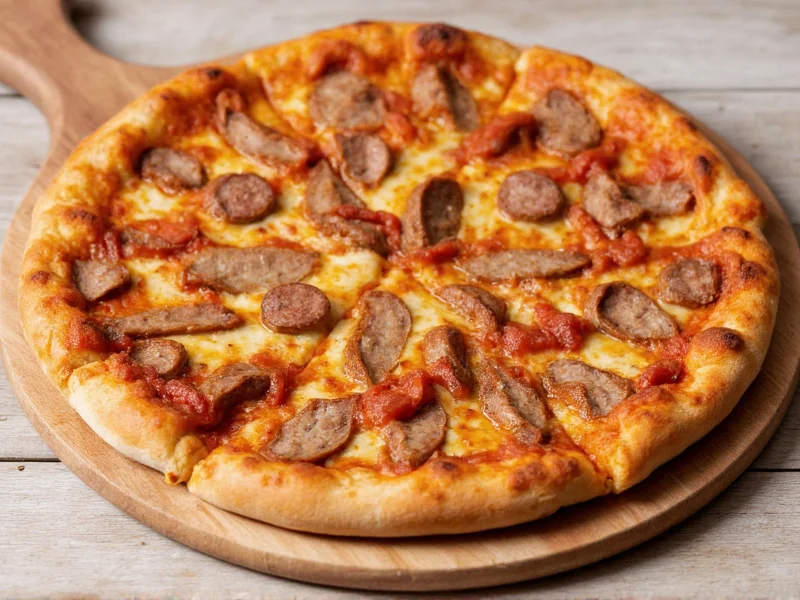The Ultimate Guide to Perfect Pizza with Sausage
Pizza with sausage represents one of America's most beloved pizza combinations, blending the rich, savory flavors of seasoned pork with traditional pizza elements. This popular menu item traces its origins to Italian immigrants who adapted their sausage-making traditions to American ingredients while maintaining authentic flavor profiles. Understanding the proper sausage selection and preparation techniques transforms this seemingly simple pizza into a culinary masterpiece that balances fatty richness with acidic tomato notes and creamy cheese.
Types of Sausage for Pizza Excellence
Selecting the right sausage makes or breaks your pizza with sausage experience. While many assume all sausages work equally well, professional pizzaiolos know that specific varieties deliver superior results when properly prepared. The fat content, seasoning profile, and cooking method all significantly impact the final pizza's texture and flavor harmony.
| Sausage Type | Fat Content | Flavor Profile | Best Pizza Application |
|---|---|---|---|
| Sweet Italian | 20-25% | Garlic, fennel, black pepper | Classic sausage pizza, sausage & pepper |
| Hot Italian | 20-25% | Spicy red pepper flakes, garlic | Spicy sausage pizza, meat lover's |
| Tuscan | 15-20% | Sage, rosemary, wine | Gourmet sausage pizza, white pizza |
| Breakfast | 25-30% | Maple, sage, nutmeg | Breakfast pizza (not traditional) |
Perfect Homemade Sausage Pizza Recipe
Creating authentic pizza with sausage at home requires attention to detail at every stage. The following professional technique ensures restaurant-quality results that showcase the sausage's flavor without overwhelming other components.
Essential Ingredients
- 1 lb sweet Italian sausage (casing removed)
- 8 oz San Marzano tomato sauce
- 12 oz fresh mozzarella (sliced or torn)
- 1 lb pizza dough (72-hour fermented preferred)
- 1 medium yellow bell pepper (thinly sliced)
- 1 small onion (thinly sliced)
- Fresh basil leaves (after baking)
- Olive oil, salt, and oregano to taste
Step-by-Step Preparation
- Pre-cook the sausage: Break sausage into small crumbles and cook in cast iron skillet over medium heat until browned but not fully cooked through (about 6-8 minutes). Remove from heat and drain excess fat, reserving 1 tablespoon for vegetables.
- Prepare vegetables: In same skillet with reserved fat, sauté peppers and onions until softened but still retaining texture (5-7 minutes). Overcooked vegetables create soggy pizza.
- Shape dough: Stretch dough to 14-inch circle on floured surface, creating raised edge for crust. Transfer to pizza peel lined with cornmeal.
- Assemble pizza: Spread thin layer of sauce (⅓ cup max), add cheese, then distribute sausage and vegetables evenly. Less is more with toppings.
- Bake: Cook at 500°F (260°C) for 10-12 minutes until crust is golden and cheese bubbles. Finish with fresh basil.
Professional Cooking Techniques for Superior Results
Mastering pizza with sausage requires understanding several critical techniques that home cooks often overlook. The moisture content of sausage presents unique challenges that, when properly addressed, yield dramatically better results.
Pre-cooking sausage properly represents the most crucial step many beginners miss. Raw sausage on pizza releases excessive fat and moisture during baking, creating greasy, unevenly cooked results. Professional pizzaiolos partially cook sausage first, then finish it in the oven with the pizza. This two-stage cooking process ensures the sausage develops proper texture and flavor without compromising the pizza's structural integrity.
Another frequently overlooked technique involves sausage distribution. Rather than scattering sausage randomly, professional chefs create small clusters that caramelize during baking, developing complex flavor compounds through the Maillard reaction. These concentrated flavor pockets create a more dynamic eating experience than evenly distributed sausage.
Regional Variations Across America
While the basic concept of pizza with sausage remains consistent, regional interpretations showcase America's diverse culinary landscape. Understanding these variations helps pizza enthusiasts appreciate the dish's evolution and adapt recipes to personal preferences.
New York Style: Features thin crust with moderate sauce and cheese, allowing the sausage flavor to dominate. Typically uses sweet Italian sausage with minimal additional toppings to avoid overwhelming the delicate balance.
Chicago Deep Dish: Incorporates sausage as a foundational layer beneath cheese and sauce. The sausage's fat renders during extended baking, flavoring the entire pie while maintaining structural integrity in the thick crust.
California Gourmet: Often features artisanal sausage varieties like fennel-free or wild boar sausage, paired with unconventional toppings like arugula, balsamic reduction, or goat cheese for sophisticated flavor profiles.
Nutritional Considerations for Pizza Lovers
Understanding the nutritional profile of pizza with sausage helps enthusiasts enjoy this classic dish responsibly. A standard 14-inch sausage pizza contains approximately 2,800-3,200 calories before additional toppings, with significant contributions from the sausage's fat content.
For those seeking lighter options, several modifications maintain flavor while reducing caloric impact. Using turkey sausage instead of pork reduces fat content by 40-50% while preserving protein levels. Pre-cooking sausage thoroughly and blotting excess fat removes up to 30% of the total fat content without sacrificing flavor. Incorporating vegetable-heavy toppings like mushrooms, spinach, or roasted peppers increases fiber content and creates a more nutritionally balanced meal.
Perfect Pairings for Sausage Pizza
The robust flavors of pizza with sausage demand thoughtful beverage pairings that complement rather than compete with its savory profile. Traditional Italian wines like Chianti or Sangiovese cut through the sausage's richness with their bright acidity and tannic structure.
For non-alcoholic options, artisanal root beer or craft ginger beer provides the necessary sweetness to balance savory elements while their carbonation cleanses the palate between bites. Even the temperature of your beverage matters—slightly chilled beverages (50-55°F) enhance the eating experience more than ice-cold drinks that numb flavor receptors.











 浙公网安备
33010002000092号
浙公网安备
33010002000092号 浙B2-20120091-4
浙B2-20120091-4